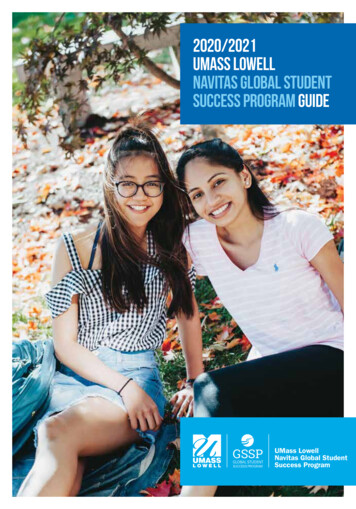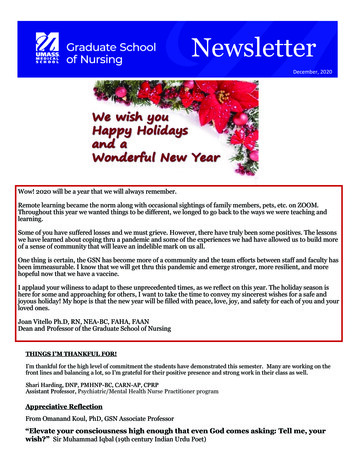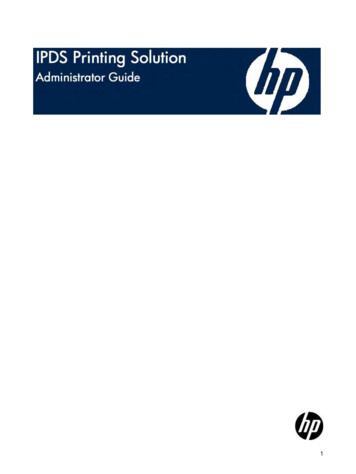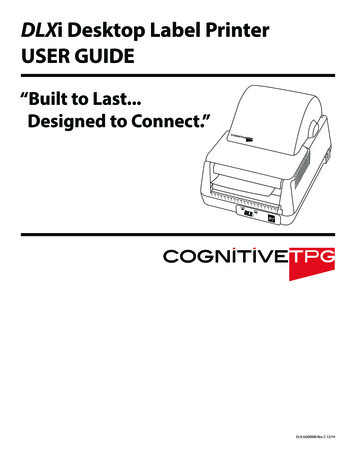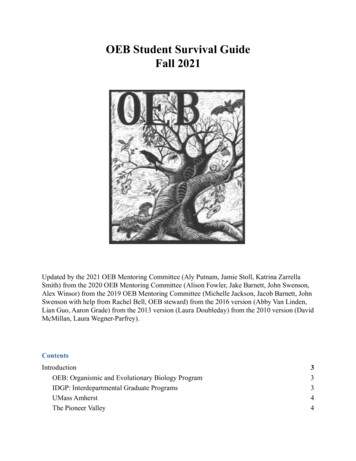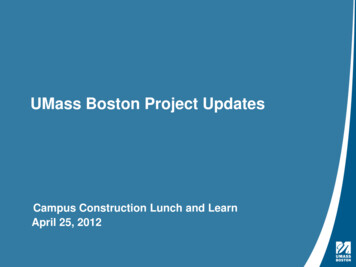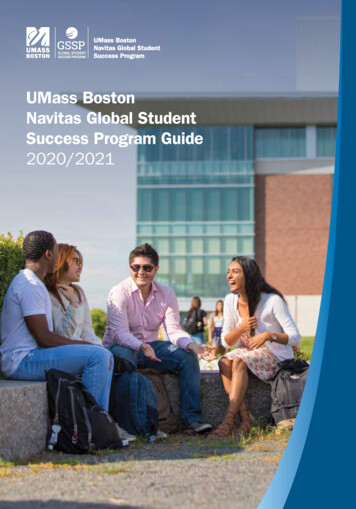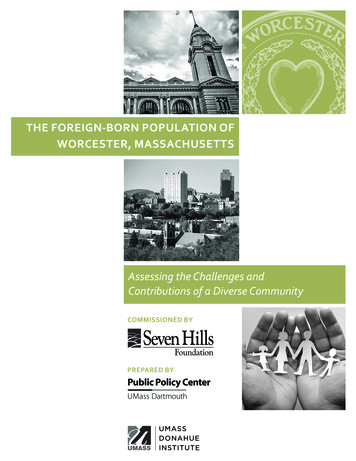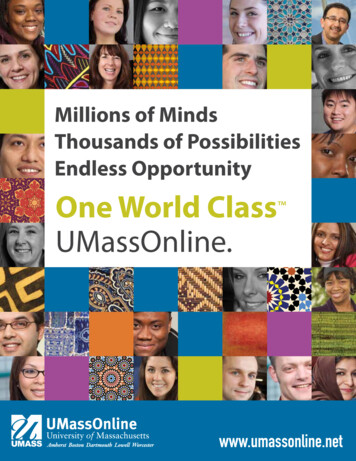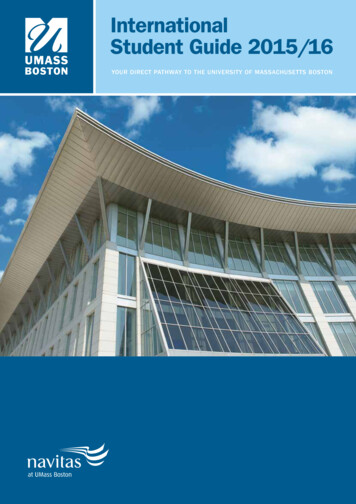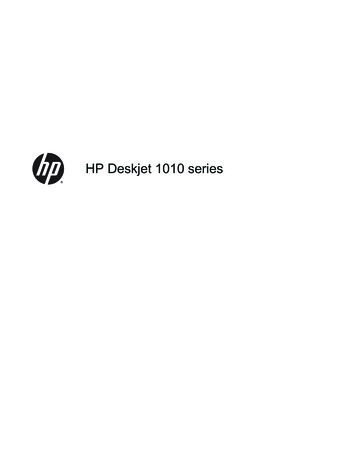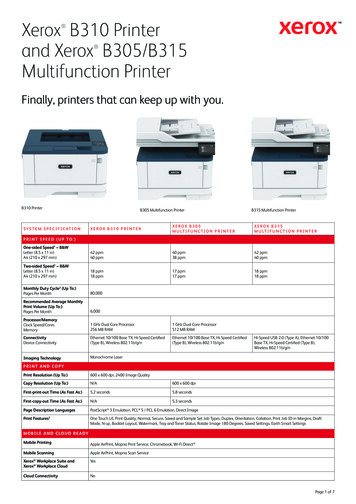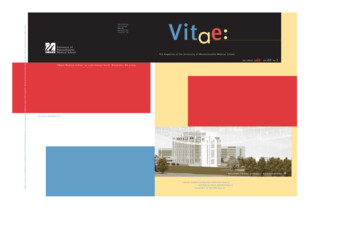
Transcription
Readers, because our mailing lists are supplied by several University departments, some of you may receive duplicate copies of this magazine. Thank you for passing them along to others who are interested in the medical school.*ƒ UMass fall / printercover4/5/001:57 PMPage 1Non-Profit Org.U.S. PostagepaidWorcester, MAPermit No. 176University ofMassachusettsMedical SchoolVitae:The magazine of the University of Massachusetts Medical SchoolFall / Winter 1999Vol.22No.1UMass Medical School 55 Lake Avenue Nor th Worcester, MA 01655Current resident or:welcome to the research neighborhoodi n s i d e : students serving their communities (page 4),extending our family eastward (page 11),and alumni, far and wide (page 17)8
*ƒ UMass fall / printercover4/5/001:57 PMPage 5C ntents:oresponsibilityto serveVitae:4L., the plural of lifewelcome to theresearchneighborhoodThe name of this magazine encompasses the lives of those who make up the UMMS community, for which it is published.They are students, faculty, staff, alumni, volunteers, benefactors and others who aspire to help this campus achievenational distinction in education, research and public service.e x te n d e d fa m i lyThe University of Massachusetts Medical School1110school of medicine, opened in 1970graduate school of biomedical sciences, opened in 1979graduate school of nursing, opened in 1986enabling thepromiseof research21525fa l l - w i n t e r 1 9 9 9alumni reportd e v e l o p m e n t u p d at e28Vitaenews & notesgrants & research1758the last word14
*ƒ UMass fall / printer4/5/0011:18 AMPage 2234oNews & N tes :aoa inducts16 graduatesfaculty selectedfor review boardsTwo UMMS faculty members havebeen appointed to review boardsfor the U.S. Department of Healthand Human Services Center forScientific Review. J o e l D .R i c h t e r , P h D , professor ofmolecular genetics & microbiology,and L e s l i e J . B e r g , P h D ,associate professor of pathology,will serve on separate study sections,which review National Institutes ofHealth grant applications and makerecommendations on applicationsto the appropriate NIH nationaladvisory council or board. Studysections also survey the status ofresearch in their fields of scienceand provide a unique opportunityfor members to contribute to thenational biomedical research effort.11Leslie J. Berg, PhD2Jordan J. Cohen, MD3James E. Hamos, PhD4John L. Sullivan, MDDr. Richter will serve as a memberof the Molecular Biology StudySection, while Dr. Berg will serve onthe Immunobiology Study Section.Richter and Berg were selectedbased on their achievements in theirscientific disciplines and willcontinue as members of their studysections until June 2002.umms links withk-12 studentsThe medical school’s Office ofScience Education (OSE) recentlyreceived a four-year, 300,000 grantfrom the Howard Hughes MedicalInstitute (HHMI) to enhanceexisting programs geared towardmaking science stimulating for K-12students. According to James E.Hamos, PhD, associate professorof cell biology and director of OSE,the funding will expand uponpartnerships created between UMMSand Worcester’s North Quadrantpublic schools over the last fiveyears — partnerships that wereaccelerated with a previous HHMIgrant of 175,000.“At UMMS, we want to alignourselves with progressive views ofscience education. The gifts we offeras a medical school — linkagesinvolving highly trained faculty, staffand students, mentoring, teacherworkshops, internships and otherhands-on activities — are crucialbecause they make science comealive, not just a subject to belearned,” said Dr. Hamos.Sixteen new graduates wereinducted into Alpha Omega Alpha,the national honor medical societyfounded in 1902 to recognize andperpetuate excellence in the medicalprofession. The new studentmembers, who were elected fromamong the top 25 percent of their1999 class, are: Jenai Beland,Ethan Samuel Brackett, Terry Ann Fortin,Eric K. Ganguly, Peter F. Graves, NancyEllen Hardiman, Annie Helgason, PattyAnn Krajewski, Rebekah ChristinaMannix, Walter P. Mutter, Todd M.O’Brien, Mark Daniel Rutstein, Alicia R.Sanderson, Jeffrey Schneider, Jesse B.Smith and Robert M. Whitehouse.commencementcelebrates 135graduatesAt its 26th annual commencementexercises held June 6, the School ofMedicine awarded 95 doctor ofmedicine degrees, including twoMD/PhDs; the Graduate School ofBiomedical Sciences, six doctor ofphilosophy degrees; and theGraduate School of Nursing, 26master of science degrees, six postmaster’s certificates and two jointdoctorate degrees in conjunctionwith UMass Amherst.Jordan J. Cohen, MD,president and CEO of theAssociation of American MedicalColleges, delivered the commencement address.2Vitaefa l l - w i n t e r 1 9 9 9Dr. Cohen was awarded an honorarydegree during the ceremony, aswas P u r n e l l C h o p p i n , M D ,president of the Howard HughesMedical Institute.Additional highlights of the ceremony included special recognitionfor L i l l i a n G o o d m a n , E d D ,dean of the Graduate School ofNursing, for a lifetime ofachievement in her field, andparting words from class speakersHenry L. Danis of the School ofMedicine, Maryellen Wrubleski ofthe Graduate School of Nursing andChristine Patricia Donahue of theGraduate School of BiomedicalSciences.hiv/aids researcherhonoredJohn L. Sullivan, MD,professor of pediatrics, pathology,and molecular genetics µbiology and world-renownedAIDS researcher, was recentlyhonored with a TherapeuticIntervention Special RecognitionAward at the second conference onGlobal Strategies for the Preventionof HIV Transmission from Mothersto Infants, held in Montreal. Dr.Sullivan played a key role in whathas been called possibly one of themost important breakthroughssince the AIDS virus was isolated.Sullivan and his UMMS colleague,Katherine Luzuriaga, MD,associate professor of pediatrics andmedicine, were involved in thediscovery of the anti-retroviral drugnevirapine in 1989, and it was atUMass that nevirapine was firstgiven to adults and children withHIV infection two years later. This,along with Sullivan's hypothesisthat nevirapine could preventmother-to-infant transmission,laid the groundwork for furtherinvestigation of the drug. Mostnotably, the National Institute ofAllergy and Infectious Diseasesrecently sponsored a large-scaleefficacy trial in Uganda whichshowed that a short course ofnevirapine, when given to HIVinfected mothers in labor and totheir babies within three days ofbirth, can reduce the HIVtransmission rate by half.The findings signaled the first bitof hope for the 600,000 to 800,000HIV-infected infants born each year,most in the developing world whereother HIV treatment regimens arefar too expensive to be used broadly.Nevirapine costs approximately 4for the treatment course, (comparedto nearly 700 for the most commonalternative, AZT treatment) and canbe given in a single dose because itstays in the bloodstream for days.The Global Strategies OrganizingCommittee recognizes keyindividuals whose foresight,scientific abilities, dedication andcompassion contribute toprevention of perinatal HIVtransmission.fa l l - w i n t e r 1 9 9 9Vitae3
*ƒ UMass fall / printer4/5/0011:18 AMePage 4R sponsibility toser veStudent involvement in public service is a matter of course and mission.providing medical care to peoplewithout health insurance. Initiatingnew public service programs forlocal communities. Igniting interestin youth about careers in science.No one has counted them, butthey’re out there: UMMS studentsof the School of Medicine, GraduateSchool of Nursing (GSN) andGraduate School of BiomedicalSciences (GSBS) are volunteeringen masse, adding to their alreadybrimming schedules to serve thecommunities and citizens of thecommonwealth.The “Goals and Objectives ofMedical Education Leading to theMedical Degree at the University ofMassachusetts Medical School”4Vitaefa l l - w i n t e r 1 9 9 9by sa n d r a l . g r aylists the knowledge, skills, valuesand attributes of a successfulmedical student. Developing anunderstanding of the doctor/patientrelationship, the needs of diversepatient populations and theeconomics of health care isenhanced through students’involvement in community service.And involved they are. Mai-LanRogoff, MD, associate dean ofstudent affairs, estimates that asmany as 90 percent of students havebeen volunteers at some pointduring their School of Medicineexperience, many in leadershiproles. “It starts with the kind ofstudents we pull in,” said Dr.Rogoff. “Admissions looks forevidence of a team player with areal interest in people. One suchpiece of evidence is communityinvolvement.”Case in point: Every Mondayevening, medical and nursingstudents join other volunteers forthe Worcester Evening Free MedicalServices Program. They gather inthe basement of Epworth UnitedMethodist Church to see everypatient who arrives throughout theevening, no appointment needed.Founded by Paul L. Hart, MD, anassociate in the Department ofFamily Medicine & CommunityHealth, this was the first of severalsuch programs in the area. In thepast five years, the volunteer staffhas treated over 10,000 uninsuredfa l l - w i n t e r 1 9 9 9Vitae5
*ƒ UMass fall / printerStudents learnabout volunteeropportunities at themedical school’sannual activitiesfair (above).Opportunities areput into action asstudents tend topatients at theWorcester EveningFree MedicalServices Program.4/5/0011:18 AMpatients. Students conduct the initialinterview, then consult with Dr. Hartand other volunteer providers,including nurse practitioners andphysicians. “Students get to be thepatient’s first contact, which is agreat opportunity for both learningand serving,” said Hart.“We experience first-handmechanisms to meet the needs ofthe underserved,” said Lloyd Fisher,’02. “It’s exciting to know I’ll beable to do this as a physician.” Inaddition to working at the program,David Blehar, ’02 coordinatesstudent volunteers. “Scheduling iseasy because so many students wantto participate. Last year, I didn’thave enough slots for everyone,” heenthused. Theresa Arpin, ’02 added,“I like the philosophy of theprogram and want to be a part of it.It’s very inspiring.”Hart sees that inspiration in action.“Every student is compassionate,top-notch, dedicated. They show upeven when they’re preparing forexams, the night after exams and allthrough the summer. The programcouldn’t operate without them.”6Vitaefa l l - w i n t e r 1 9 9 9Page 6Cheri Burrer, MS, NP, a 1999graduate of the GSN, is lookingforward to returning to the programas a volunteer, reliving her dayswhen, as a student, she “workedalongside volunteers who werehappy to be a part of the program.Helping the needy confirmed myfeeling that I entered the right fieldof work,” Burrer added.Direct clinical care is an obvious wayfor future caregivers to contribute,but not the only way. MarniSilverstein, ’02, one of three studentleaders for the Department ofPediatrics’ Book Buddies Program,enjoys reading stories to younginpatients because “kids enjoy a visitfrom someone who doesn’t doanything that hurts them.” She feelsthe children give back as much asthey receive. “You can get caughtup in studying and lose sight ofwhy you’re in medical school.Volunteering provides perspectiveand balance.”This fall, Mandy Coles, ’02, avolunteer counselor for AIDS ProjectWorcester, takes over the StudentsTeaching AIDS to Students (STATS)program. With its goal of providingbasic HIV and AIDS education to10th graders in the Worcester publicschools, STATS offers Coles anopportunity to “do something thatwill make a difference even before Ibecome a doctor.”The Division of PediatricEndocrinology’s Juvenile DiabetesHalloween Party gets a big boostfrom student volunteers. Formernurse, School of Medicine graduateand resident Patty-Ann Krajewski,MD, wanted to help after her godsonwas diagnosed at age five. Dr.Krajewski secured donations andrecruited plenty of studentmanpower to produce an annualgala that is organized and staffedentirely by students. They come fullycostumed and ready to fete theyoung diabetics with fun, gamesand sugar-free treats.responsibilityto serveit’s in the campuscultureCommunity service is so importantat the GSN that it’s part of thecurriculum. The service requirementwas added several years ago because“nurses need to know they have aresponsibility to serve theircommunity,” explained Dean andProfessor Lillian R. Goodman, EdD.Nurses first learn how to conduct acommunity needs assessmentthrough coursework. In their clinicalyear, they select a community,conduct an assessment and identifyservices that can be offered bymaster’s-level nurses.All GSBS students receive a stipendto serve the commonwealth full-timeas research assistants. Such anassignment can mean 16-hourworkdays, including time spentconducting research and teaching.Yet many of these gifted scientistsembrace a more hands-on approachas volunteers. Dean Thomas B.Miller Jr., PhD, has observed thecampus culture evolve over theyears. “Under Chancellor AaronLazare’s leadership, we have becomea more caring institution. Peoplewant to help and serve theircommunity.”Carol Kerwin-Mushnick, RN, a GSNgeriatric nurse practitionercandidate, planned a service projectto help elders in her hometown ofMillis. Kerwin-Mushnick and projectpartner Jennifer Critchlow, RN,developed “Don’t Get Caught inthe Cold!” — a presentation thateducates seniors about the dangersof hypothermia. “No matter whatI do, whether professionally orpersonally, I want it to have meaningand significance, to make adifference,” said Kerwin-Mushnick.For the past two years, predoctoralcandidate Carlo DiBonaventura hasbeen a hit with students at NorthHigh School, where he mentors viathe Worcester Pipeline Collaborative.While the collaborative is a funded,staffed UMMS initiative, studentvolunteers are the lifeblood ofseveral of its K-12 science educationprograms. DiBonaventura visitshealth classes to talk abouteducation, careers and anything elseon students’ minds. He is pleasedthat such activity “allows me to reacha lot of kids in my limited time.”With the hope of making it easier forUMMS students and communityagencies to connect, GSBS studentLaurie Boyer and School of Medicinestudent Jennifer Keating arecollaborating to establish UMassCAREs (Community Awareness,Responsibility and Education).They envision the organization willprovide a means by which studentscampuswide can link with volunteerprograms, building on existingmethods like the annual studentactivities fair and Serving theUnderserved, a student-written grant.UMass CAREs promises to helpbusy medical, nursing and basicscience students squeeze in onemore commitment, make onemore contribution, help one moreperson. “As individuals we wantto contribute,” Boyer summed up.“The schools help make thispossible in many ways.”fa l l - w i n t e r 1 9 9 9Vitae7
*ƒ UMass fall / printer4/5/0011:19 AMPage 8The view fromBelmont andPlantation streets(left) and theview from acrossthe “quad.”eW lcometo the research neighborhoodby m a r k l . s h e lto nThe UMass research enterprise will soon have room to grow withconstruction of a new research laboratory building on campus.when the University ofMassachusetts Medical Schoolbreaks ground in December on anew research laboratory buildingfor the Worcester campus, thelandscape will change both literallyand figuratively. With 10 floors andmore than one third of a milliongross square feet, a dramatic glass“curtain wall” overlooking theoriginal granite buildings, and akey position at the gateway to thecampus, the new building willinstantly become the signatureUMMS structure for the newmillennium.Metaphorically as well, the newlaboratories will herald a change inthe research landscape — not justfor the medical school, but for theregion and beyond. When thebuilding is fully occupied, morethan 100 principal investigators atthe cusp of great scientific changewill lead UMMS in an unprecedentedexpansion of its mission.8Vitaefa l l - w i n t e r 1 9 9 9“There is a national expectationby Congress and by the NationalInstitutes of Health that medicalschools provide leadership inresearch,” said Chancellor andDean Aaron Lazare, MD. “As ourresearchers continue to makediscoveries and explore new avenuesof inquiry, we recognize that inorder to continue to fulfill ourmission, our research enterprisemust grow. And in order to grow,we simply need more space.”The new building will not only haveample space, it will have efficientspace: An innovative laboratorydesign and layout will maximizelab bench space while providingunprecedented opportunities forcollaboration and sharing ofresources. The lab layout —described as a “linear equipment”design by GPR Planners Cooperative, which is programmingand planning the laboratories —will attain the maximum amountof usable research space from thestructure; more than 200,000square feet of research space whenfully fitted.Surrounding those lab bencheswill be a building that architectCarol Chiles AIA, the projectexecutive for Tsoi/Kobus &Associates, believes will change theimage of the campus by finishingthe “quadrangle” implied by themedical school and hospitalbuildings. “The new building isan opportunity to create indeliblya new ‘first impression’ of themedical school,” she said.“This is an exciting project forTsoi/Kobus & Associates because itis an opportunity to transform thecampus and create a buildingthat gives something to the entirecampus through its public spacesand meeting rooms — a buildingthat surprises people a little by beingmore than they expected.”fa l l - w i n t e r 1 9 9 9Vitae9
*ƒ UMass fall / printer4/5/0011:19 AMPage 10The new buildingcompletes thequadrangle (left).Inside, a marvelouslyefficient floor plan.extendedBuilding images Tsoi / Kobus & AssociatesThe public spaces on the first andsecond floors are integral to thehabitability of the building. Plansinclude a walkway connecting thenew facility to the parking garage,a 200-seat dining complex, andseveral conference and meetingrooms. Above the second floor, thelaboratory floors are connected byopen atria surrounding the centralstaircases, in an effort to promotecollaboration and community.(Chiles refers to these as “researchneighborhoods.”) Faculty andgraduate student offices fill thecurtain wall in the front of thebuilding, facing the quad;laboratories and research spaceface Plantation Street.“Part of the challenge of the designcomes from, first, the prominenceof the site, and second, from theneed to ‘face’ in two directions,”explained Chiles. “At urbancampuses, new buildings are oftenburied in a forest of existingstructures, whereas here, the newbuilding will command attention.Too, while the entrance of thebuilding faces the quadrangle,10Vitaefa l l - w i n t e r 1 9 9 9there’s also a ‘front’ on PlantationStreet, because that’s such animportant thoroughfare for UMMSand the biotechnology park.”“We’re going to fill this buildingwith great researchers and greatscientists,” enthused Dr. Lazare.“Some of them are already on thefaculty, and others will ‘recruitthemselves’ to Worcester as they seeall of the exciting things happeningaround our research enterprise. Weknow that research growth isnecessary to retain and recruit thebest faculty; research growth isessential for outstanding education,for the success of our clinicalpartner, UMass Memorial, and forthe success of our efforts to curedisease and eliminate humansuffering. At a time when medicalschools like ours are recognized askey to the advancement ofbiomedical science, this buildingwill be a key part of the futureof UMMS.”million cost will be paid for in partby philanthropy. A fundraisingcampaign for the building isanchored by a 5 million pledgefrom the Massachusetts AFL-CIO forcancer research programs within itsnew walls. In addition, 30 millionin funding for cutting-edge researchwas pledged by UMass MemorialHealth Care at the time of themerger of Memorial Health Carewith the UMass clinical system in1998.Tsoi/Kobus & Associates ofCambridge is an architecture firmwith a national reputation forlaboratory and academic buildingdesign. Beacon Skanska, USA, oneof the foremost constructiondesign firms in the world, will bethe lead contractor. BR A waschosen as the mechanical systemscontractor, while GPR Plannersof Purchase, N.Y., is designing thelaboratory layout.lfami yby ly n n c . b o r e l l aAt UMMS’ campus to the east, vaccine productionand disease-screening procedures help ensure thehealth of New Englanders.Groundbreaking for the newbuilding is scheduled for December1999; occupancy is planned forSeptember 2001. The estimated 100fa l l - w i n t e r 1 9 9 9Vitae11
*ƒ UMass fall / printer4/5/0011:19 AMPage 12In the 1950s, “Mr.Tetanus” Bill Lenthamprepares the virus forvaccinations at theMassachusettsBiologic Laboratories,where he was anemployee for 36 years.Blood samples from New England’s newborns are sorted and stored at NENSP(left). NENSP’s Tom Zytkovicz, PhD, chief of laboratories; Roger Eaton, PhD;and George Grady, MD, discuss the state-of-the-art screening capabilities ofthe tandem mass spectrometer.future promisealthough situated more than 40miles east of the UMass MedicalSchool campus, the state laboratorycomplex in Jamaica Plain plays anintegral role in the school’s publicservice mission. The UMMSoperated facilities, housing theMassachusetts Biologic Laboratoriesand the New England NewbornScreening Program, are beneficiariesof the natural interface between themedical school and the state’sprimary public health provider, theDepartment of Public Health,whose labs are also located withinthe facilities.Equally noteworthy, the staff at theJamaica Plain campus — whobecame UMMS employees in 1997— truly embody the public serviceand research aspirations of themedical school. It is these 240individuals — employees dedicatedto ensuring that safe and effectivevaccines and plasma products arepublicly accessible and thatnewborns are screened early fortreatable disorders — who aremaking this transition a positiveone for UMMS.12Vitaefa l l - w i n t e r 1 9 9 9a long, rich historyProjecting a family atmosphere, theemployees of the MassachusettsBiologic Laboratories (MBL) worktoward a common goal: “making thebest products in the world,”according to Roger Anderson, PhD,MBL senior director of processdevelopment and technical services.This philosophy has driven the labs’success for more than 100 yearsand created their unique positionas the only publicly-operated, FDAlicensed vaccine manufacturingfacilities in the country.Since 1894, when the DPH established the facility, the laboratorieshave introduced vaccines to preventdiphtheria, pertussis, tetanus andother diseases. Employees alsopioneered the use of immuneglobulins, a class of proteins takenfrom the blood plasma of humansimmune to a specific disease. Theseimmune globulins provide passiveprotection against diseases.According to MBL Director DonnaAmbrosino, MD, UMMS’ acquisitionof the laboratories affords the state aunique opportunity to combinecutting-edge research, educationand health care. “These arewonderful facilities that have servedthe public in so many importantways,” noted Dr. Ambrosino. “Webring to the medical school a long,rich history of bright scientists andcommitted workers who displayexceptional quality andinventiveness.”a s t a f f f av o r i t eThe first UMMS-appointed director,Ambrosino said she and DeputyDirector Jeanne Leszczynski, MD,plan to use their expertise toenhance the labs’ current capacitiesto develop new products. MBLSenior Director Andersonconcurred. “UMass is supportive ofour need to expand. This supporthas helped me tremendously inperforming my job — creating andvalidating the processes that convertresearch ideas into licensedproducts.” Plans are also underwayto expand the laboratories’ physicalplant to better accommodate currentand future manufacturingopportunities.“No one likes to carry the news thata baby has a disorder,” said ProgramCoordinator Cecelia McGonagle, a23-year veteran of NENSP. “But toknow that we detect problems earlyenough to prevent clinicalcomplications is probably the mostrewarding part of the job.”The New England NewbornScreening Program (NENSP)occupies a warm spot in the heartsof many Jamaica Plain employees.Since its inception in 1962, theformer DPH program — nowadministered by UMMS — hasprovided health screening for over 3million infants in Maine, Vermont,New Hampshire and Rhode Island,as well as Massachusetts, andidentified nearly 2,000 newbornswith significant clinical disorders.The technicians and physicianswho work at NENSP strive to affordnewborns the opportunity todevelop to their fullest potential.The staff analyzes blood specimenstaken from newborns atMassachusetts’ birthing hospitalsand hospitals in the four other statesthe NENSP serves and tests thespecimens for a series of disordersthat, if left unrecognized anduntreated, could compromise achild’s health. The staff undertakesaggressive tactics to find any babysuspected of having a disorder.“I feel like I’m making a differencein someone’s life, even if it’s anindirect one,” said Melody Rush,manager of specimen processing.Rush’s job, orchestrating the flow ofspecimens to the appropriate labs,increased in complexity this pastFebruary when the DPH directed theNENSP to expand testing throughseveral pilot studies. To meetmodern standards regardingpatients’ rights and pilot studies,NENSP included mechanisms forparents to participate in the decisionas to whether their babies are testedfor these “pilot study disorders.”The expanded screening increasedthe number of tests from nine to 30,and an informational outreachcampaign was launched, includingdevelopment of a Web site andbrochure. In addition, specialpresentations and mailingstargeted nursery managers andother health care providers,ensuring that these key personnelunderstood the expanded programand its implications for the state’snewborns and their families.“Massachusetts was alreadyscreening its population for moredisorders than any other state in thecountry; implementation of thenewly expanded screening extendsthis program’s leadership role intothe future,” said NENSP ActingDirector Roger Eaton, PhD.Throughout its two-year presenceon the Jamaica Plain campus, UMMShas worked to maintain a stableenvironment for MBL and NENSPstaff. James Hill, assistant vicechancellor for CommonwealthMedicine, plans to use hisexperience as former DPH associatecommissioner to make this“cohabitation” continue to work.“Because of my background, I havea unique opportunity to serve asthe bridge between DPH and UMMS.My challenge is to take the administrative structure that has been createdand make it so routine that it allowsthe day-to-day business function torecede into the background.”George Grady, MD, a 30-year veteranof the labs who is now medicaldirector for NENSP, offers a specialperspective on UMMS’ administration of the campus. The formerdirector of the MBL, NENSP andseveral other DPH programs, Gradyadmits that laboratory science was a“bit of an orphan” under a stateagency. He added, “Historically,legislators and policy people werenot mentally programmed to thinkof science existing anywhere butwithin a university. By taking overoperation of most of the complexfunctions of the laboratories, UMassis giving us presumed legitimacy tonot only analyze specimens, but alsoto conduct research. I’m hoping forthe best of both worlds.”fa l l - w i n t e r 1 9 9 9Vitae13
*ƒ UMass fall / printer4/5/0011:19 AMPage 14enabling thep ro m i s eo f re s e rchaGrants & Research :New and competitive renewal grants of 50,000 and up are listed here accordingto broad areas of research and funding sources.by m a r k l . s h e lto nalcohol abusen at i o n a l i n s t i t u te s o f h e a lthAlejandro M. Dopico, MD, PhD, researchassistant professor of pharmacology &molecular toxicology: Ethanol actions onSLO channels from arteries vs. brain, oneyear, 108,456; recommended for fourmore years, 430,720.The new licensing agreement between one of UMMS’ leading researchersand a leader in biotechnology foretells lifesaving breakthroughs.arthritis/rheumatologyn at i o n a l i n s t i t u te s o f h e a lthResearch by Aldo A. Rossini, MD,the William and Doris KruppProfessor of Medicine, and hiscolleagues in the UMMS Divisionof Diabetes has been licensed toCambridge-based biotechnologygiant Biogen. The research andclinical relationship will includemore than 1 million in sponsoredresearch, licensing and milestonefees and royalties on futureproduct sales.The research agreement, negotiatedby the Office of CommercialVentures & Intellectual Property,covers discoveries by Dr. Rossiniand Professors of Medicine DaleGreiner, PhD, and John Mordes,MD, that indicate a new mechanismby which transplanted organs andtissues may survive without beingrejected by the recipient. The workis a further extension of research14Vitaefa l l - w i n t e r 1 9 9 9that induced long-term tolerancefor transplanted islet cells in mice— work that The Harvard Health Lettercalled “one of the top ten medicaladvances of the year” whenpublished in 1995.“Dr. Rossini and his colleagues areamong the most creative andinnovative researchers in the entirefield of immunology, and thislicensing agreement with one of thetop companies in the biotech field isa concrete example of the promisethat basic science research holds,”said Chancellor and Dean AaronLazare, MD. “Aldo’s work may verywell lead to a whole host of lifesaving clinical applications,including his career-long effort toeffectively eliminate the scourgeof diabetes.”The research licenses covermethods which “trick” a person'simmune system into long-termacceptance of foreign tissue, suchas an organ transplant. Thework may have wide implicationsfor organ and bone marrowtransplantation, includingtreatment for diabetes. In addition,recent refinements by Rossini’slab hold broad promise forsuccessful human applications;so promising that Biogen andRossini anticipate human clinicaltri
president of the Howard Hughes Medical Institute. Additional highlights of the cere-mony included special recognition for Lillian Goodman, EdD, dean of the Graduate School of Nursing, for a lifetime of achievement in her field, and parting words from class speakers Henry L. Danis of the School of Medicine, Maryellen Wrubleski of
